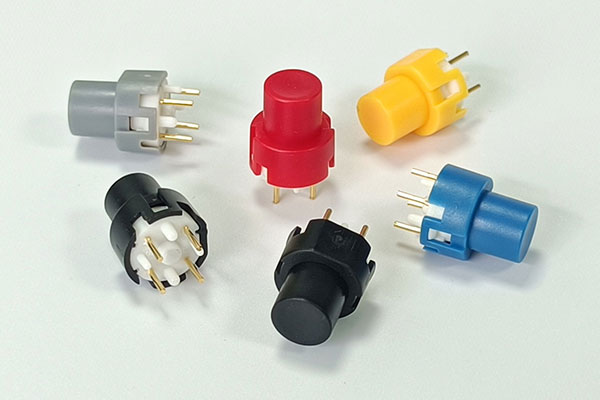Knowledge
which switch will be used for the synthesizer?
When designing a synthesizer, selecting the right type of switch is crucial, as it impacts not only the functionality and user experience but also the overall build quality and durability. For synthesizers, particularly modular synthesizers or smaller portable setups, there are a few common switch types used: tactile switches, push-button switches, rotary encoders, and sliders. Each has its place depending on the specific function they will serve within the instrument.

1. Tactile Switches
Tactile switches, like the TS4 Red Round SPST Momentary PCB Mount Tactile Switch, are popular in synthesizer designs for certain key interactions, particularly on control panels or as part of interface buttons. The key characteristic of tactile switches is their physical feedback — the user feels a small "click" or a mechanical bump when pressing them. This feedback makes them ideal for:
Mode switches: When switching between different modes on a synthesizer, tactile switches offer clear tactile feedback, reassuring the user that a mode change has occurred.
Patch buttons: Modular synthesizers, in particular, often use tactile switches for patch selection or changes in the routing of signals, as their feedback ensures the user knows the patch has been activated or modified.
Trigger buttons: In certain types of synthesis, such as drum machines or trigger-based sequencing, a tactile switch can act as a trigger button, activating a specific sound or sequence.
The TS4 Red Round model, with its compact size and momentary function, is particularly suitable for smaller, portable synthesizer setups where space is at a premium but responsiveness is still important.
2. Push-Button Switches
Push-button switches, especially metal push-button switches, are more commonly used in synthesizer designs where a more robust switch is needed for user interaction. These are generally used in:
Power switches: Larger, more rugged push-button switches are often used for the power switch of a synthesizer, given their long life expectancy and tactile feedback.
Function selection: On more complex synthesizers, you may find push-button switches assigned to specific functions like volume control, modulation settings, or toggling between preset patches. Their clear "click" sound and smooth action make them ideal for this application.
In addition to their durability, push-button switches are also more aesthetically versatile. They can be made from metal and anodized in various colors, which can make them stand out on a synthesizer’s front panel.
3. Rotary Encoders
Rotary encoders are often used in synthesizers for knob-based controls, such as frequency modulation, filter cutoff, and other parameters that require continuous, variable input. Unlike tactile or push-button switches, rotary encoders allow for precise control of a parameter's value, which is essential for synthesizers that rely on a range of settings to shape sounds.
Applications: These are primarily found on knobs for filter cutoff, resonance, oscillator tuning, volume, and other customizable parameters. Unlike potentiometers, which provide a continuous analog signal, rotary encoders often produce digital signals, sending steps that the synthesizer processes to produce the desired effect.
4. Sliders
Sliders are another important component for parameter control in synthesizers. While switches may serve discrete functions, sliders are best for continuous control of things like envelope attack/release or filter cutoff, allowing users to make smooth adjustments to sound parameters.
Use Cases: In larger synthesizers or modular systems, sliders allow for more precise control of audio parameters, as users can see and feel the changes in real time. These are typically used for dynamic parameters that need precise, on-the-fly adjustments.
5. Momentary vs. Latching Switches
An important distinction between switches for synthesizers is whether they are momentary or latching switches. A momentary switch (like the TS4 Red Round SPST) is one that only stays engaged while it is physically pressed. This type of switch is used when a temporary action is required, such as triggering a sound or activating a function for a limited time (e.g., starting a sequence or triggering a drum hit).
A latching switch, on the other hand, locks into place once pressed and stays engaged until pressed again. These are often used in on/off functions or for toggling between settings, like turning on/off the entire synthesizer or enabling/disabling a particular modulation function.
6. Other Considerations
Durability: As synthesizers are often used in live performance settings, the switches must be durable and able to withstand constant use. This is why metal push-button switches and high-quality tactile switches are favored, as they offer longevity and reliability.
Size and Form Factor: For compact synthesizers, choosing small, low-profile switches can be critical to saving space while still providing the tactile feedback or functionality needed.
In conclusion, the switch used in a synthesizer will largely depend on the role it plays in the overall user interface and functionality. Tactile switches are ideal for user feedback, while push-button and rotary encoders serve different levels of control depending on whether the user requires discrete or continuous input. When selecting switches for a synthesizer, it’s essential to balance the needs of tactile feedback, durability, and precise functionality.
RELATED NEWS
- Types of Anti-Vandal Switches 2025-02-28
- Where Are Anti-Vandal Switches Used 2025-02-27
- The tact switch with integrated LED for illumination vision 2025-02-27
- Introduction to LED Tact Switches 2025-02-18
- An Article For Emergency Stop Push Button 2025-02-11
CATEGORIES
LATEST NEWS
CONTACT US
Contact: Bella
Phone: 15999819066
E-mail: rucoe@rucoe.com
Whatsapp:+86-15999819066
Add: Taoyuan Street, Nanshan, Shenzhen
